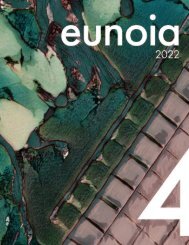WSU EUNOIA Volume II
Washington State University, School of Design + Construction student work for the academic year of Summer 2020 - Spring 2021
Washington State University, School of Design + Construction student work for the academic year of Summer 2020 - Spring 2021
Create successful ePaper yourself
Turn your PDF publications into a flip-book with our unique Google optimized e-Paper software.
“it is hopeful that inmates can return to their communities
as resourceful beings rather than being redundant or
getting back to recidivism.”
Figure 2: Inmates practicing
meditation in Rhode Island men’s
prison. 10
“… farming at the present is the
hinterland of economics out there
on the borderland of despair.” 5
Wright describes farmers as
the unacknowledged idol of
our economy. Farmers and
the agrarian lifestyle are lost
among the middlemen who try
to commercialize food and fresh
produce. An attempt to hybridize
a few phases of correction facilities
with these farmlands would allow
its inmates to transform their goals
in vocational aspects, thus making
them a part of the (agrarian)
community. A case of this
hybridization is seen in the H-Unit
at San Quentin State Prison; here
inmates are exposed to gardening
and horticulture techniques as a
progressive form of skill-based
education (Fig.1). This is seen as
an addition to both their schedules
and common space within their
facility. Measures to take part in this
initiative along with a disciplined
routine of meditation before the
session helps in the concept of
rehabilitating an individual. 6 The
initiative reiterates the scared
(horizontal) connection that man
must have with the ground as
mentioned by Wright. On coming
down to the soil, be it for pulling
weeds or planting a new sapling,
inmates are allowed to nurture
plants, which can be an expression
of Wright’s freedom.
With laws, substance, and drug
abuse being a major reason
for the rise in the number of
incarcerated individuals, 8 it
seems appropriate that mindful
awareness and rehabilitation
must be incorporated within
correctional facilities. Looking at
wellness (healthcare) as another
typology that can complement
the ‘agrarian-prison’ can promote
mental support and can boost
confidence within inmates.
Apart from traditional facets of
healthcare, providing spaces
like playgrounds, meditation
gardens, support groups, would
help in addressing and accepting
the psychological upbringing of
inmates in harsh prison environments
(Fig.2). Such programs can develop
an individual’s outlook on being
a part of the community therefore
reducing their rates of recidivism. 9
Proposing a decentralized hybrid of
correctional facilities would demand
more allocation of area, more staff,
and funds. On the flip side, looking
at secondary typologies (farms and
wellness centers) it is hopeful that
inmates can return to their communities
as resourceful beings rather than
being redundant or getting back to
recidivism.
Development concerning the pressing
issues in the field of agriculture and
healthcare can be implemented on
prison inmates, thus humanizing the
approach to their treatment. This can
benefit both the inmates and the social
issues (in agriculture and healthcare)
by creating an awareness of a model
society in correctional facilities. This
horizontal spread of the hybrid would
fit parallel with Wright’s idea of a
progressive school, where the student
takes responsibility for their learning.
Similarly, this prison hybrid would
open from confined secure spaces
to semi-open wellness and personal
care spaces to autonomous (open)
farmlands, which could eventually
pave way for a ‘changed’ individual
to be at the beginning of the food
supply chain in conjunction with or by
helping the farmer.
REFERENCES
1 Frank Lloyd Wright, The Living City
(New York, NY: New American Library,
1958), 208.
2 Ibid., 209
3 Michael Jacobson, Downsizing
Prisons: How to Reduce Crime and End
Mass Incarceration (New York and
London: New York University Press,
2005), 19.
4 Dr. Ron Wallace, “5 Of the Biggest
Challenges Facing Corrections in
2019,” Corrections1 (American
Military University, December 11,
2018), https://www.corrections1.
com/2018-review/articles/5-of-thebiggest-challenges-facing-correctionsin-2019-
b9Afg8ZhS84p06uT/.
5 Frank Lloyd Wright, The Living City
(New York, NY: New American Library,
1958), 174.
6 Kalliopeia Foundation, “Breaking
New Ground,” Beyond Prison, May
19, 2016, https://www.beyondprison.
us/chapter/breaking- new-ground/.
7 Ibid.,
8 The Sentencing Project , “The Science
of Downsizing Prisons – What Works?”
(The Sentencing Project , February
2013), https://www.sentencingproject.
org/wp-content/uploads/2016/02/
The-Science-of-Downsizing-Prisons-
What-Works.pdf, 1.
9 Kalliopeia Foundation , “Path of
Freedom #Beyondprison,” Beyond
Prison, April 19, 2016, https://www.
beyondprison.us/chapter/path-offreedom/.
10 Ibid.,
“
Class led by Ayad Rahmani
38 39
volume ii
eunoia





